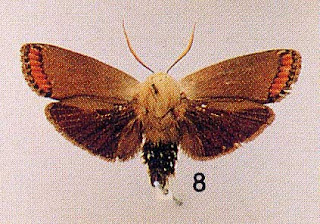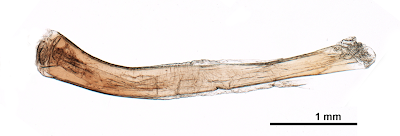Thysiarcha Meyrick, 1925
Thysiarcha Meyrick, 1925. Exotic Microlepidoptera. 3 (5–7): 129–160, 161–192, 193–224 [146]. Type species: Cryptophasa ecclesiastis Meyrick, 1887 by original designation.
Thysiarcha Meyrick, 1925 [Cryptophasidae]. Fletcher, T. B., 1929, A list of generic names used for Microlepidoptera. Memoirs of the Department of Agriculture of India, 11: 1-244 [223].
Thysiarcha Meyrick, 1925. Common, in Nielsen, Edwards, & Rangsi, 1996, Checklist of the Lepidoptera of Australia. Monographs on Australian Lepidoptera, 4: i-xiv, 1-529 & CD-ROM [88].
Thysiarcha Meyrick, 1925. Beccaloni, G. W., Scoble, M. J., Robinson, G. S. & Pitkin, B. (Editors). 2003. The Global Lepidoptera Names Index (LepIndex). World Wide Web electronic publication. http://www.nhm.ac.uk/entomology/lepindex [accessed 1 May 2010].
Thysiarcha Meyrick, 1925. Edwards, E. D. (2003), Xyloryctinae. Australian Faunal Directory. Australian Biological Resources Study, Canberra. http://www.environment.gov.au/biodiversity/abrs/online-resources/fauna/afd/taxa/XYLORYCTINAE [accessed 17 June 2010].
Original description, Meyrick 1925
Thysiarcha, Meyrick 1925
Differs from Cryptophasa in the singular aborted labial palpi; these are extremely short, porrected, second joint with appressed scales, obtuse, terminal joint obsolete. Forewings: 8 to apex.
Type ecclesiastis Meyr.; when describing this species, from a single specimen, I supposed the palpi to be broken, but other specimens have since been obtained, proving the condition to be normal. No other species of Cryptophasa approximates to it.
Description:
Head:
Thorax:
Abdomen:
Immature stages:
Distribution: New South Wales, Queensland, Victoria. Endemic. (Edwards, 2003).
Remarks:
_____________________________________
Thysiarcha ecclesiastis (Meyrick, 1887)
Thysiarcha ecclesiastis♀ - NSW, Menai, (ANIC) [AMO].
Thysiarcha ecclesiastis♂ - NSW, Ellenborough, 1. Dec. 1963, F. Branchgrove leg. (LWC). [AMO].
Thysiarcha ecclesiastis♂ - Qld, Springbrook Lat. 28' 11'' S Long. 153' 15'' E, 26. Nov. 1991, I.F.B. Common leg. (ANIC). [AMO].
Thysiarcha ecclesiastis♀ - Qld, Prince Henry Heights, Toowoomba Lat. 27' 5'' S Long. 151' 59'' E, 20. Dec. 1985, I.F.B. Common leg. (ANIC). [AMO].
Thysiarcha ecclesiastis♂ - NSW, CSIRO Experimental Farm, Wilton, 8. Jan. 1965, V.J. Robinson leg. (ANIC). Figured in Moths of Australia [AMO].
Thysiarcha ecclesiastis, QM, showing sexual dimorphism.
Cryptophasa ecclesiastis Meyrick, 1887, Descriptions of New Lepidoptera. Proceedings of the Linnean Society of New South Wales, 2-n.s. 1(4): 1037-1048 [1040]. Holotype SAMA ♀, Dandenong Range, Vic.
Cryptophaga ecclesiastis. Illidge, 1895: Xylorycts, or timber moths. Queensland Natural History Society Transactions, 1, 29-34.
Cryptophaga ecclesiastis Meyr. Turner, 1898. The Xyloryctidae of Queensland. Annals of the Queensland Museum 4: 1–32 [11].
Thysiarcha ecclesiastis (Meyr.). Meyrick, 1925. Exotic Microlepidoptera. 3 (5–7): 129–160, 161–192, 193–224 [146].
Cryptophasa ecclesiastis Meyrick. D’Abrera, 1974, Moths of Australia, Lansdowne Press, Melbourne, 1-79.
Thysiarcha ecclesiastis (Meyr.). Common, 1990, Moths of Australia, Melbourne University Press. 227-230 [230].
Thysiarcha ecclesiastis (Meyrick, 1887). Common, in Nielsen, Edwards, & Rangsi, 1996, Checklist of the Lepidoptera of Australia. Monogr. Aust. Lepid 4: i-xiv, 1-529 & CD-ROM [87].
Thysiarcha ecclesiastis (Meyrick, 1887). Beccaloni, G. W., Scoble, M. J., Robinson, G. S. & Pitkin, B. (Editors). 2003. The Global Lepidoptera Names Index (LepIndex). World Wide Web electronic publication. http://www.nhm.ac.uk/entomology/lepindex [accessed 17 June 2010].
Thysiarcha ecclesiastis (Meyrick, 1887). Edwards, E. D. (2003), Xyloryctinae. Australian Faunal Directory. Australian Biological Resources Study, Canberra. http://www.environment.gov.au/biodiversity/abrs/online-resources/fauna/afd/taxa/XYLORYCTINAE [accessed 19 June 2010].
Original description, Meyrick 1887
Crypt ecclesiastis n. sp.
♀. 66 mm. Head and thorax white. Antennae fuscous. Abdomen white, above with a broad black transverse band before middle, and five slender black rings between this and apex, apical scales yellowish-tinged. Legs white, anterior and middle tibiae banded with black, all tarsi black with white rings. Forewings elongate-oblong, costa bent before middle, apex rounded, hindmargin rather oblique, hardly rounded; shining white; a narrow coppery hindmarginal fascia, forming alternate purple and golden spots: cilia white, barred with dark fuscous. Hindwings shining white; a narrow coppery-purplish hindmarginal fascia; cilia white.
Dandenong Range, Victoria; one specimen taken by Dr. T. P. Lucas.
Subsequent description, Turner, 1898
Cryptophaga ecclesiastis, Meyr. Meyrick, Proceedings of the Linnean Society of New South Wales, 1886, 1040; and op. cit. 32. Male, 30-35 mm.; antennal pectinations, 3; forewings fuscous; hind wings dark-fuscous with a purple iridescence; abdomen dark-fuscous. Female, 53-59 mm.; forewings very pale whitish-grey; hindwings similar, suffused with fuscous towards hindmargin. (Meyrick’s type from Victoria was shining white.)
This species is readily distinguished by the curious coppery-purple hindmarginal fascia. It is also characterised by the minute labial palpi. Brisbane: four specimens bred by Mr. Illidge from larvae tunnelling the stems of Eucalyptus corymbosa (Bloodwood).
Other references
D’Abrera, 1974, showing size dimorphism
C. ecclesiastis Meyrick is markedly sexually dimorphic, the female having the appearance of a gothic-vestmented cleric with arms outspread – hence its name. (D’Abrera, 1974).
Pl. 6.8: Common, 1990
Pl. 6.9: Common, 1990
The male of T. ecclesiastis (Meyr.) (Pl. 6.8) which has brown-black wings with a purplish iridescence, is very different from the female (Pl. 6.9), although both have a submarginal row of coppery purplish spots on both wings. The labial palpi in both species are extremely short. The species occurs from southern Queensland to Victoria and the larvae bore into the stems of bloodwood Eucalyptus gummifera (Myrtaceae). (Common, 1990).
Diagnosis:
Description:
Thysiarcha ecclesiastis, 06-NSWE-01953, m, Tom's Creek Retreat, Ellenborough, New South Wales, 31.459E, 152.476S, 118 m. Collected by P.D.N. Hebert, 17 December 2005. (BOLD:AAE335). Genitalia disected below.
Thorax:
Abdomen:
Thysiarcha ecclesiastis, male genitalia. 06-NSWE-01953.
DIssected by Patrick Strutzenberger, ©BOLD.
Thysiarcha ecclesiastis, clasper. 06-NSWE-01953.
DIssected by Patrick Strutzenberger, ©BOLD.
Thysiarcha ecclesiastis, uncus and gnathos. 06-NSWE-01953.
DIssected by Patrick Strutzenberger, ©BOLD.
Thysiarcha ecclesiastis, saccus and juxta. 06-NSWE-01953.
DIssected by Patrick Strutzenberger, ©BOLD.
Food plants: Larva boring in stem. Larval foodplant: Eucalyptus gummifera (Myrtaceae). (Edwards, 2003).
Flight period: November, December, January.
Distribution: New South Wales, Queensland, Victoria. Endemic. (Edwards, 2003).
Remarks:
Updated 17 September 2019.
+Menai+NSW+F.jpg)
+NSW+MTHYSIARCHA+ecclesiastis+(Meyrick,+1887)+NSW+M.jpg)
+Springbrook+Qld+M.jpg)
+Toowoomba+Qld+F.jpg)
+Wilton+NSW+M.jpg)










